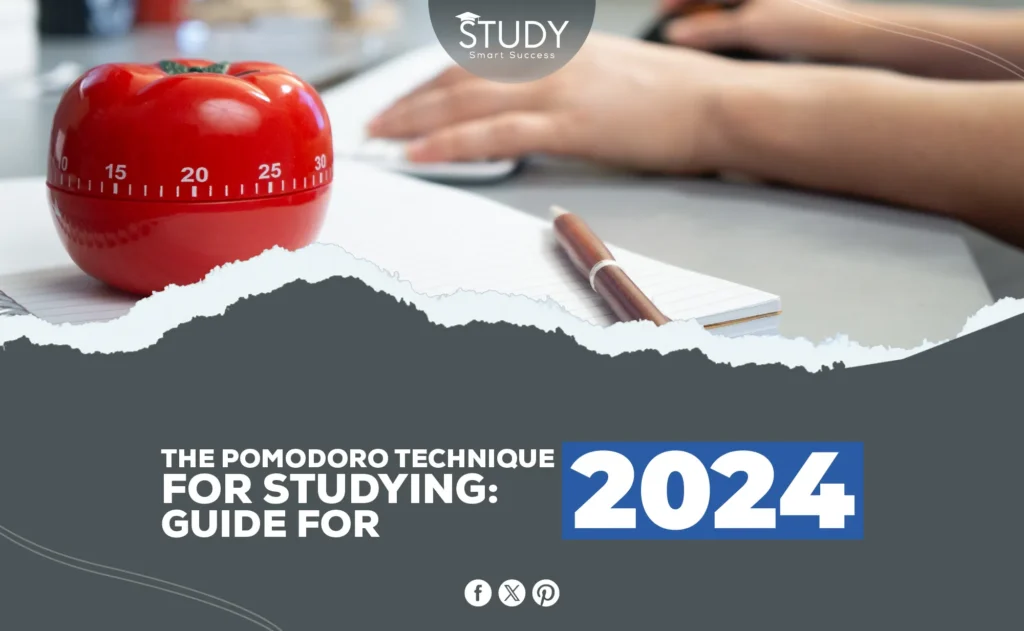Introduction
This is Content Updated on May 24, 2024.
The Pomodoro Technique is a time management method that can help students improve focus, manage distractions, and increase productivity while studying. This comprehensive guide will discuss the details of this technique, its benefits, and how to implement it effectively for successful study in 2024. In addition, we will consider some questions that people search for.
- Pomodoro Technique ADHD
- Is the Pomodoro technique effective?
- Does the Pomodoro technique work?
- Why is it called the Pomodoro technique
Understanding the Pomodoro Technique
The Pomodoro Technique is a widely recognized time management strategy created by Francesco Cirillo in the late 1980s. The technique entails dividing study periods into concentrated intervals, usually 25 minutes, interspersed with brief pauses. The methodology is founded on the concept that regular rest intervals can enhance cognitive flexibility and general efficiency.
Benefits of Using the Pomodoro Technique for Studying
The implementation of the Pomodoro Technique can result in numerous advantages for students, such as:
- Augmented attention and mental acuity while engaging in study sessions
- Enhanced ability to allocate and utilize time effectively.
- Minimized procrastination and distractions
- Enhanced preservation of academic content
- Alleviating study-induced stress and burnout
Implementing the Pomodoro Technique for studying, Step-by-Step
Step 1: Establish Explicit Study Objectives
Before commencing a Pomodoro session, it is imperative to establish unambiguous study objectives for the forthcoming interval. One could accomplish this by finishing a textbook segment, revisiting lecture notes, or tackling practice questions.
Step 2: Configure the timer and initiate the Pomodoro technique.
After determining the study objective, initiate a timer for 25 minutes, which is the customary duration of a Pomodoro session. Many applications and online timers can be utilized for this specific objective.
Step 3: Maintain concentration on the assigned task.
Throughout the 25 minutes, ensure consistent and undivided attention to the assigned study assignment. Eliminate potential sources of interruption, such as engaging with your phone or surfing the internet, and concentrate only on the subject.
Step 4: Pause briefly
After completing the 25-minute interval, allocate a brief 5-minute period to relax and replenish your energy. Utilize this period to engage in stretching exercises, procure a nutritious snack, or unwind before commencing the subsequent Pomodoro session.
Step 5: Iterate the Procedure
Resume another 25-minute Pomodoro session after the little intermission. Reiterate this sequence several times before pausing, usually 15-30 minutes, to revitalize and contemplate.
Now it is time to look at our Questions that are given above.
Q1: Pomodoro Technique ADHD: A Detailed Overview
The Pomodoro Technique is a widely recognized time management strategy known for its straightforwardness and efficiency in enhancing concentration and productivity. The Pomodoro Technique can be a beneficial strategy for improving focus and study effectiveness in individuals with Attention Deficit Hyperactivity Disorder (ADHD).
Applying the Pomodoro Technique ADHD:
Implementing the Pomodoro Technique for those with ADHD:
Organized Time Allocation:
The Pomodoro Technique offers a systematic method for managing time, especially advantageous for those with ADHD who may encounter difficulties with time perception and organization. The specified time intervals establish a feeling of urgency and serve as a deterrent to procrastination.
Brief periods of concentrated attention:
The brief and concentrated intervals are well-suited to the limited attention span of those with ADHD. Dividing the study session into smaller, more manageable parts aids in avoiding cognitive exhaustion and sustaining focus.
Integrating intervals:
Intermittent pauses between Pomodoros are essential for those with ADHD. These intervals provide opportunities for short rest periods, which help prevent exhaustion and enhance prolonged concentration during concentrated activity.
Alleviating Overwhelm:
When faced with a great deal of responsibility, people with ADHD may be more likely to feel overwhelmed. The Pomodoro Technique encourages people to work on their tasks without feeling overwhelmed by breaking them up into smaller, more manageable chunks.
Establishing a Regular Schedule:
Implementing the Pomodoro Technique aids those with ADHD in establishing a consistent study environment. Establishing regular and predictable schedules helps individuals feel more in command and secure, diminishing feelings of unease and enhancing overall efficiency.
Time tracking and progress monitoring:
The Pomodoro Technique integrates a monitoring mechanism, enabling participants to trace their development chronologically. Individuals with ADHD find this particularly motivating since it visually depicts their achievements and reinforces a feeling of success.
Enhanced responsibility:
The Pomodoro Technique’s regimented nature fosters a sense of responsibility and obligation. Being aware of a timer’s operation can assist individuals in maintaining attention and resisting distractions, so promoting a study session that is more concentrated and productive.
Q2: Is the Pomodoro technique effective?
The Pomodoro Technique is a very efficient method for enhancing study productivity. The technique benefits students academically because of its disciplined time management, capacity to boost focus, and emphasis on minimizing burnout. The efficacy of it can be assessed using the following criteria.
Effectiveness:
Successful Time Management:
Time management is organized using the Pomodoro Technique. By breaking up study sessions into 25-minute Pomodoros, people learn to solve problems methodically. This study framework simplifies time management with a clear plan.
Better Focus and Clarity:
The Pomodoro Technique improves focus and concentration. Periodic intervals provide urgency, encouraging full focus on the task at hand. Focus improves study efficiency and productivity.
Overcoming Procrastination:
Academically, procrastination is difficult. The Pomodoro Technique works by setting time limitations for each session. Limited time makes it harder to put off or avoid studying, encouraging a proactive and rigorous approach.
Preventing Burnout:
Burnout can be avoided by incorporating short Pomodoros. These breaks allow people to refresh their minds, reducing cognitive fatigue. Thus, pupils can study for extended periods without tiring.
Task management and prioritization
Breaking study work into smaller chunks improves task management. The Pomodoro Technique encourages prioritizing work, focusing on the most important ones, and learning methodically. The study session becomes more productive and efficient.
Flexibility in focus duration:
The Pomodoro Technique matches attention span swings. The brief, focused intervals accommodate the brain’s ability to keep attention for long durations, making it versatile for people with various attention spans. The adaptability ensures that the technique works in numerous learning situations.
Monitoring and Encouraging Progress:
A tracking method in the Pomodoro Technique lets students track their development. Visualizing achievements boosts satisfaction and dedication to the current work. Seeking tangible progress improves study habits.
Interval and welfare promotion:
The Pomodoro Technique’s frequent intervals improve well-being. Students should take short breaks from schoolwork to improve their mental and physical health. This emphasis on intervals fosters a balanced approach to academic activities, recognition of efficiency, and individual well-being.
Q3: Why is it called the Pomodoro Technique?
The word “pomodoro” is derived from the Italian “tomato.” The approach bears the name of Francesco Cirillo, a university student who kept track of his work intervals using a tomato-shaped kitchen timer. This timer’s use is credited with creating the “Pomodoro Technique.” Since then, it has gained recognition as a widely used technique for increasing output and time management.
Conclusion
In conclusion, the Pomodoro Technique offers a structured approach to studying that can significantly enhance productivity and focus while reducing study-related stress. By implementing this method, students can effectively manage their time, improve concentration, and achieve better academic outcomes. Embracing the Pomodoro Technique in 2024 can be a game-changer for students seeking to optimize their study habits and excel academically.




